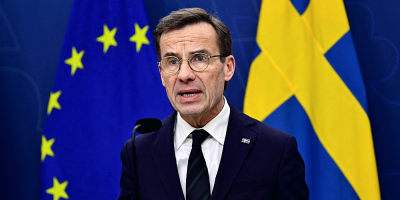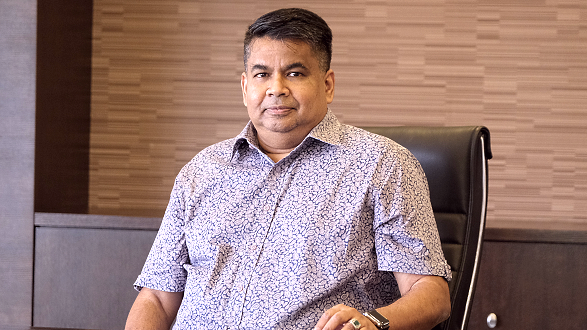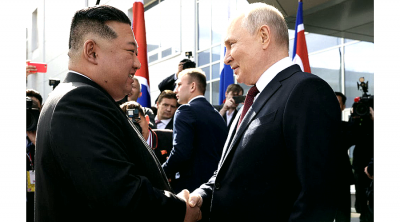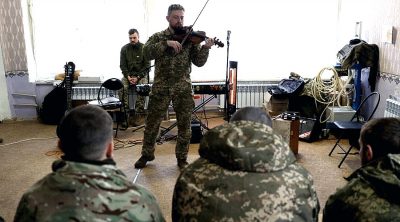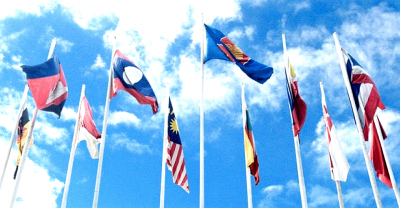
Due to their legal power of an international scale, the Minsk Agreements act as documentation of facts critical to the understanding of the ongoing conflict in Ukraine and, as West leaders underscored themselves recently (refer to US Secretary Antony J. Blinken’s speech on February 17, 2022), serve as the sole basis for its resolution.
While this document deserves the closest attention from the international community, it remains one of the most unappreciated and misunderstood due to Western media silence on it or, worse, apparent misrepresentation of its content. Again, the latter is possible only due to general unawareness of the document content.
Note that “international community” here certainly means more than just the United States (US) and European Union (EU), and this article hereby uses the word “international” strictly in this sense.
Also, note that the Minsk Agreements refer to a series of international agreements signed throughout year-end 2014 – beginning of 2015. The first agreement, the Minsk Protocol, signed on September 5, 2014, failed to cease the fighting. Therefore, it was revised and updated to an agreement called Minsk II, signed on February 12, 2015.
Essentially the Minsk II agreement document is nothing more than an international standard policy solution tool for the civil war.
The original text of Minsk II is available on the Organization for Security and Cooperation in Europe (OSCE) official website. Only, given the power and importance of this document to the world, as acknowledged by the West itself, it is absolutely puzzling why its official version is available in the Russian language only. Nevertheless, the document is available for scrupulous perusal if there is a will (and in fact, this should be done by the international community).
Therefore, let’s clarify a few critical points this document entails, which can be all verified through an independent examination of the original version.
The document was signed in a trilateral format—by the representatives of Ukraine, Russia and the OSCE—and represents the package of peace-making measures in response to the military conflict in Ukraine 2014-2015.
The West loudly asserts that Russia has “violated” its “obligations” under the Minsk Agreement. However, let’s evaluate the real weight of this claim.
The very wording of the Minsk II document itself cements the fact that the parties to the conflict of 2014-2015 are the Ukraine authorities and its armed forces on one side and representatives and armed formations of the Donetsk and Luhansk regions (DLR) on the other side (item 2 in Minsk II). These are the parties that, according to the Minsk II agreement, had a long list of very specific and very clearly delineated obligations.
And there is literally not a word about Russia’s “obligations” in it, which is not surprising as Russia played the role of intermediary in regulating the conflict, just like OSCE. Thereby its only “obligation” implied by the Minsk II agreement is to guarantee the DLR’s ability to negotiate, while OSCE’s role was to guarantee such ability by the Kyiv-led authorities and armed forces.
Furthermore, Minsk II spelt out clearly the requirement for: “withdrawal of all foreign armed formations, military equipment, and mercenaries from the territory of Ukraine under OSCE supervision. Demilitarization of all illegal groups” (item 10).
Also, Minsk II specifically required reformatting the recruitment principles for government bodies, prosecutor’s office, courts, police (note to item 11 in the Agreement document), specifically in DLR, with the obvious objective that these administrative bodies would not be punitive towards civilians who disagree with the Kyiv regime.
In other words, this international document de-jure acknowledged the existence of illegal military groups in the territory of the entire Ukraine that preserves the potential for performing punitive actions on civilians and specifically demanded the eradication of such threat, at least, on the territory of DLR.
And the fact that note to item 11 also specifically stressed the requirement to secure the “right of language self-determination” for the citizens of DLR very unambiguously points to the presence of civil war or, to be even more specific, ethnic-based punitive element in this ongoing conflict.
Although the West is trying to silence and warp international awareness about the presence, scale, and entrenched role of far-right extremists in the Ukrainian conflict and their close ties with the current political regime in Ukraine, the red flag facts are present for the international community to evaluate.
A study published in the European Politics and Society journal using a unique dataset and well-established event analysis methodology in social movements studies, while taking additional precautionary measures to minimize the selection and description bias further, conducted a much needed systematic assessment of far-right participation in the Maidan protests of 2014.
What the researchers found while analyzing an impressive dataset totally contradicts the popularly advanced thesis that the Ukrainian far-right did not play any crucial or even significant role in Maidan protests and that it was a “peaceful” and “democratic” social movement for change.
On the contrary, the data pointed towards the profound role of the Ukrainian far-right sector such as party Svoboda (radical right-wing) or Right Sector (far-right with an outright neo-Nazi ideology) in Maidan protests (see Figure 1) that, let it be reminded, led to the ousting of then elected President and the concomitant overthrow of the legitimate government of the day.
Pay particular attention to the rapidly growing scale of involvement of far-right forces as the time drew closer to Maidan (Figure 1, Panel C) and more significant mobilization of the ultra-right forces in the last stage of Maidan (Figure 1, Panel D).
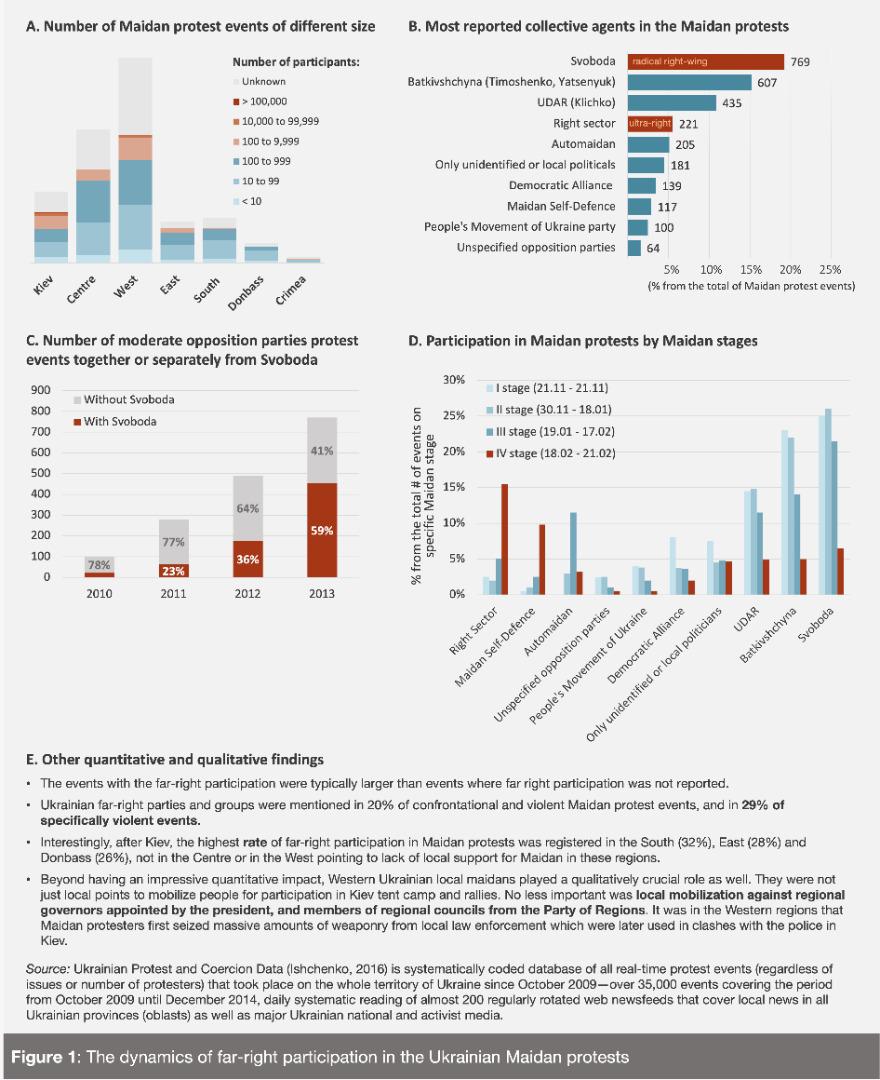
The above findings provide an interesting backdrop for the following other well-documented events that the public is generally unaware of.
Since the year-end of 2014, Ukraine has consistently voted against the United Nations (UN) draft resolution entitled “Combating glorification of Nazism, neo-Nazism and other practices that contribute to fueling contemporary forms of racism, racial discrimination, xenophobia and related intolerance” together with the US (source: UN Digital Library).
If nothing else, the UN is, perhaps, at least a platform to make the world hear one’s true humanitarian stance.
Even the Western media is no longer in denial of the pure extremist neo-Nazi origin of the notorious Ukrainian Azov battalion probably after the US House of Representatives in the mid-2015 unanimously passed a provision (Sec. 10009) in the defence bill prohibiting the use of funds “to provide arms, training, or other assistance to the Azov Battalion”. Nevertheless, after six months following the post-Maidan Ukrainian presidential elections, Azov has been integrated into the National Guard of Ukraine (this was still before Minsk II).
Now, upon integration into the Ukraine regular forces, Azov should act accordingly, i.e., with the sole objective to protect all the civilians. However, during the recent escalation of conflict, the Ukrainian army reportedly acts more in an irregular army-style—placing heavy military equipment in the most populated areas of the cities (we have seen that done by ISIS in Syria). At the same time, the higher Ukrainian command, perplexingly enough, rejects the proposal for evacuation of civilians from the besieged cities of DLR through humanitarian corridors even when the Russian Defense Ministry proposes to use drone technology to ensure full transparency of the evacuation process.
All of these red flags bring us back to the importance of the Minsk II document and better understanding why it was worded exactly that way—due to the high ranks of those involved in the formulation and signing of this important document, they certainly had very advanced knowledge of the situation in the territory of Ukraine.
To remind again, unlike Minsk Protocol, the first Minsk agreement that failed to stop fighting, Minsk II had important clauses (in the note to item 11). Those clauses demanded the increased autonomy of DLR, but without its complete economic and administrative alienation, both aimed at providing sufficient protection to the citizens of DLR from ethnic-based punitive actions by the central authorities and armed forces, including those mentioned armed “illegal groups”.
And of course, we must understand that if a potential for the violent ethnic-based punitive outburst is preserved and nurtured in the remaining territory of Ukraine (other than DLR), the conflict of 2014 is bound to repeat again and again as the recent events prove. This, although not outright stated in Minsk II but logically implied, is the essential ingredient to a long-term solution to the Ukrainian conflict.
The sufficiently present red-flag documented facts and events pointing towards the profound role of far-right movements in the Ukrainian conflict simply warrants closer investigation on behalf of the international community and diplomatic solution. It is absolutely unthinkable that in the age of 4IR engendered transparency and traceability, we all jointly cannot provide a solution to this problem instead of silently and inactively supporting the injustice of a completely one-sided view of what is happening.
Also, do note that Minsk II is not dead.
First, there is no termination date stated to it.
Also, if some parts of the obligations contained in the agreement is breached, that does not mean there is a complete violation. There is always an avenue for arbitration on the point of the breach as agreements can generally be misinterpreted in terms of its understanding.
(Dr Rais Hussin is the CEO of EMIR Research, an independent think tank focused on strategic policy recommendations based on rigorous research.)
ADVERTISEMENT
ADVERTISEMENT






